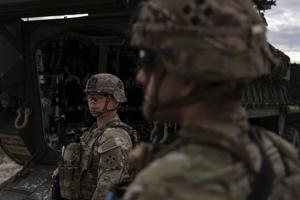US Military Expands Role at Border, Deploys 7,600 Troops Now

UPDATE: The U.S. military has dramatically escalated its presence at the Mexico-U.S. border, with 7,600 troops now deployed to deter illegal crossings. President Donald Trump initiated this strategy, which has sparked significant changes in how border enforcement is conducted, particularly in Nogales, Arizona.
Just this week, an Army scout spotted a potential illegal entry from atop the border wall, triggering a rapid response from U.S. Border Patrol. As alarms blared, the individual retreated back into Mexico, highlighting the urgent nature of the military’s involvement. The deployment of troops has tripled since early April, even as apprehensions have hit a 60-year low, raising questions about the effectiveness of this approach.
The military’s new role is centered from a command post near the Huachuca Mountains, where battalion commanders coordinate operations using advanced technology. In a significant shift, large sections of the border are now designated as militarized zones, allowing troops to engage in law enforcement actions that were traditionally the purview of civilian authorities.
Army Maj. Gen. Scott Naumann leads this expanded mission, emphasizing the military’s ability to respond swiftly and effectively to smuggling activities. “We can fly people into incredibly remote areas now that we see the cartels shifting course,” he stated, reflecting the urgency of adapting to evolving tactics used by smugglers.
Despite the recent decrease in crossings, Naumann warns that a resurgence could occur as summer heat subsides. The military’s resources include 117 armored Stryker vehicles, over 35 helicopters, and long-range drones capable of monitoring the border continuously.
Community sentiment in Nogales is mixed; while some residents appreciate the increased security, others express concerns over the militarization of their neighborhoods and the potential implications for civil liberties.
Legal experts are also weighing in on the ramifications of this militarized approach. The deployment raises questions regarding compliance with the Posse Comitatus Act, which restricts military involvement in domestic law enforcement. “It’s in that gray area,” commented Joshua Kastenberg, a law professor and former Air Force judge.
As the Trump administration pushes forward with its immigration strategy, additional funding has been authorized for 3,000 Border Patrol agents, complete with incentives to recruit and retain personnel. The urgency of the situation is palpable as authorities continue to adapt to new challenges at the border.
What happens next remains critical. With an ongoing military presence and evolving tactics, communities and policy observers are closely watching how this situation unfolds in the coming weeks. The intersection of military power, law enforcement, and immigration policy marks a pivotal moment in U.S. border management, with significant implications for all stakeholders involved.
Stay tuned for more updates on this developing story.






